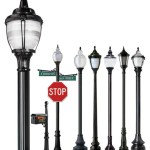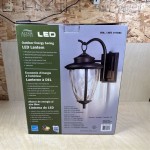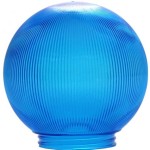Solar PIR Outdoor Wall Lights: Illuminating Security and Efficiency
Solar PIR (Passive Infrared) outdoor wall lights represent a significant advancement in residential and commercial security and energy efficiency. Combining the renewable energy source of the sun with intelligent motion detection, these lights offer a practical and environmentally conscious solution for illuminating outdoor spaces. Understanding the underlying technology, benefits, and practical applications of solar PIR outdoor wall lights is crucial for making informed decisions about their implementation.
These lights generally consist of several key components working in concert. A solar panel captures sunlight and converts it into electricity. This electricity is then stored in a rechargeable battery, typically a lithium-ion battery due to its high energy density and long lifespan. A PIR sensor detects movement within its designated range. Upon detecting motion, the sensor triggers the light to activate, providing illumination. Finally, an LED (Light Emitting Diode) light source provides the actual illumination. The combination of these components allows for automatic, energy-efficient lighting without the need for external wiring or electricity costs.
Understanding the Technology
The core of a solar PIR outdoor wall light's functionality lies in the efficient conversion and storage of solar energy. The solar panel, usually made of monocrystalline or polycrystalline silicon, absorbs photons from sunlight. This absorbed energy excites electrons within the silicon, creating an electric current through the photovoltaic effect. Monocrystalline panels are generally more efficient and durable but also more expensive compared to polycrystalline panels.
The generated electricity is then channeled to a rechargeable battery. Lithium-ion batteries are preferred in these applications due to their ability to store a significant amount of energy relative to their size and weight, their high cycle life (number of charge and discharge cycles before significant degradation), and their minimal self-discharge rate. The battery provides power to the LED light source and the PIR sensor when needed.
The PIR sensor is a crucial element in the intelligent activation of the light. These sensors detect changes in infrared radiation within their field of view. All objects emit infrared radiation, and when a warm object, such as a person or animal, moves within the sensor's range, it causes a change in the detected infrared radiation. This change triggers the sensor to activate the light. PIR sensors are designed to be relatively insensitive to changes in ambient temperature and light levels, minimizing false triggers.
Modern solar PIR outdoor wall lights often incorporate microcontrollers to manage the charging process, monitor battery health, and control the activation and duration of the light. These microcontrollers can also implement features such as adjustable sensitivity for the PIR sensor, allowing users to fine-tune the sensor's responsiveness to different types of motion, and adjustable light duration, allowing control over how long the light remains on after motion is detected.
Benefits and Advantages
Solar PIR outdoor wall lights offer a range of benefits compared to traditional wired lighting solutions. Perhaps the most significant benefit is their energy efficiency. By harnessing solar energy, these lights eliminate the need for grid electricity, reducing energy consumption and associated costs. This also translates to a smaller carbon footprint, contributing to a more sustainable lifestyle.
Installation is significantly simplified with solar PIR outdoor wall lights. Because they operate independently of the electrical grid, there is no need for complex wiring or the involvement of an electrician. These lights can be easily mounted on any exterior wall or surface using basic tools. This ease of installation makes them an ideal choice for DIY projects and for areas where running electrical wiring would be difficult or expensive.
Another significant advantage is their cost-effectiveness over the long term. While the initial purchase price may be higher than that of traditional lights, the elimination of electricity bills quickly offsets this cost. Furthermore, LED light sources have a significantly longer lifespan than incandescent or fluorescent bulbs, reducing the need for frequent replacements. The long lifespan of the solar panel and battery also contribute to the overall cost-effectiveness of these lights.
Beyond energy efficiency and cost savings, solar PIR outdoor wall lights enhance security. The sudden illumination triggered by motion detection can deter potential intruders, providing an effective security measure for homes and businesses. The lights can also illuminate pathways and entryways, improving visibility and reducing the risk of accidents.
Finally, these lights offer increased versatility. They can be installed in a wide range of locations, including remote areas where access to electricity is limited. Their portable nature allows for flexible placement and easy relocation as needed. This makes them suitable for use in gardens, patios, driveways, sheds, and other outdoor spaces.
Practical Applications and Considerations
Solar PIR outdoor wall lights find application across various settings, from residential homes to commercial properties. In residential settings, they are commonly used to illuminate driveways, walkways, patios, and entryways, providing security and enhancing curb appeal. They can also be used to light up garden paths and steps, improving safety and visibility at night.
For commercial properties, these lights provide security and illumination for parking lots, loading docks, and other outdoor areas. They can also be used to light up signage and building entrances, improving visibility for customers and employees. The cost savings associated with solar energy make them a particularly attractive option for businesses looking to reduce their operating expenses.
When selecting a solar PIR outdoor wall light, several factors should be considered. The size and type of solar panel are important. Larger panels generally produce more electricity, allowing for longer illumination times. Monocrystalline panels offer higher efficiency but come at a higher cost. The battery capacity is another critical consideration. Higher capacity batteries can store more energy, providing longer illumination times during periods of limited sunlight.
The range and sensitivity of the PIR sensor should also be evaluated. A wider range allows for motion detection over a larger area, while adjustable sensitivity allows users to fine-tune the sensor to minimize false triggers. The brightness of the LED light source is another important factor. Brighter lights provide better illumination, but they also consume more energy. Look for lights with adjustable brightness settings to optimize energy efficiency.
The durability and weather resistance of the light are also important considerations, especially in harsh climates. Look for lights made from durable materials such as aluminum or stainless steel, with a weather-resistant rating (e.g., IP65 or higher) to protect against rain, snow, and other environmental elements.
Finally, consider the aesthetics of the light. Solar PIR outdoor wall lights come in a variety of styles and finishes to complement different architectural designs. Choose a light that not only provides functional illumination but also enhances the overall appearance of the property.
Installation of solar PIR outdoor wall lights is generally straightforward but requires careful planning. Choose a location that receives ample sunlight throughout the day to ensure optimal charging of the battery. Avoid placing the light in shaded areas or under trees, as this will reduce the amount of sunlight that reaches the solar panel. Ensure the mounting surface is strong and stable to support the weight of the light. Use appropriate mounting hardware and follow the manufacturer's instructions carefully.
Regular maintenance is essential to ensure the long-term performance of solar PIR outdoor wall lights. Clean the solar panel periodically with a soft cloth to remove dust and debris. Inspect the battery compartment for corrosion and replace the battery as needed. Check the PIR sensor for any obstructions and clear away any vegetation that may trigger false alarms. By following these simple maintenance steps, users can ensure that their solar PIR outdoor wall lights continue to provide reliable and efficient illumination for years to come.

20 Led Solar Power Pir Motion Sensor Wall Light Outdoor Garden Waterproof Lamps

Solar Pir Led Wall Light Outdoor Garden Security Waterproof Motion Sensor Lights

2 Pack Waterproof 40 Led Solar Powered Pir Motion Sensor Wall Light Outdoor Security Lights Garden Yard Porch Lamp Com

2 Pack Waterproof 40 Led Solar Powered Pir Motion Sensor Wall Light Outdoor Security Lights Garden Yard Porch Lamp Com

6000w Led Solar Wall Lights Pir Motion Sensor Outdoor Garden Street Fence Light

Solar Powered 118 Led Wall Lights Pir Motion Sensor Outdoor Security Lamp Garden

Solar Fence Lights Outdoor Wall Deck Auto On Off Waterproof Mounted Decorative For Yard Pillar Porch Temu

2 Pack Waterproof 40 Led Solar Powered Pir Motion Sensor Wall Light Outdoor Security Lights Garden Yard Porch Lamp Com

600w 72 Cob Led Solar Wall Light Motion Sensor Pir Outdoor Garden Security Street Lamp Ip65 For Porch Gutter Barn Deck Fence Patio Path 6 Pack Com

234 Led Split Solar Wall Light With Remote Control Ip65 Water Resistant Pir Motion Sensor Security Floodlight For Outdoor Patio Yard Garage Garden Lights Temu
Related Posts







